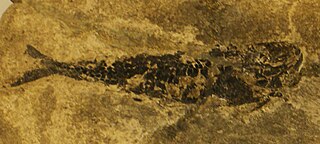Aetheolepis is an extinct genus of ray-finned fish which lived in freshwater environments in what is now Western Australia and New South Wales during the Jurassic period. It contains one species, A. mirabilis. Aetheolepis was previously thought to be an archaeomaenid, until a 2016 study instead recovered it as a member of the family Dapediidae. Like other dapediids, it had a deep, discoid-shaped body. Fossils of A. mirabilis have been found in the Talbragar River fossil beds of New South Wales and the Colalura Sandstone of Western Australia. It was named by Arthur Smith Woodward in 1865 along with other Talbragar fish.

Atopocephala is an extinct genus of prehistoric freshwater ray-finned fish that lived during the Middle Triassic epoch. It contains a single species, A. watsoni from the Karoo Supergroup of South Africa. A potential indeterminate species was known from the Timezgadiouine Formation of Morocco, but is now considered an indeterminate actinopterygian.
Arctosomus is an extinct genus of prehistoric freshwater bony fish that lived during the Early Triassic epoch of Krasnoyarsk Krai, Russia. It contains a single species, A. sibiricus.
Tripelta is an extinct genus of prehistoric bony fish that lived during the Anisian age in what is now New South Wales, Australia.
Daedalichthys is an extinct genus of prehistoric freshwater ray-finned fish that lived during the Early Triassic epoch. It contains a single species, D. formosa from the Olenekian-aged Cynognathus Assemblage Zone of South Africa. It was previously classified in Dictyopyge.

Brookvalia is an extinct genus of prehistoric freshwater ray-finned fish that lived during the Middle Triassic epoch.
Sakamenichthys is an extinct genus of prehistoric bony fish that lived during the Early Triassic epoch in what is now Madagascar. Fossils were recovered from beds of the Middle Sakamena Formation of the Beroroha basin in the southern part of the island.
Agecephalichthys is an extinct genus of prehistoric freshwater "palaeonisciform" ray-finned fish that lived during the Anisian age. It contains a single species, A. granulatus from the Hawkesbury Sandstone in what is now New South Wales, Australia.

Acrolepis is an extinct genus of prehistoric marine bony fish that lived from the Famennian stage of the Devonian to the early Triassic epoch. Some species from the Early Triassic of Tasmania are also ascribed to Acrolepis.
Gigantopterus is an extinct genus of prehistoric bony fish that lived during the Carnian stage of the Late Triassic epoch.
Caruichthys is an extinct genus of prehistoric freshwater ray-finned fish that lived during the Early Triassic epoch. It contains a single species, Caruichthys ornatus, known from what is now South Africa. It is known from a single specimen, which was collected from the middle Beaufort Series of Doorn River.
Luganoia is an extinct genus of prehistoric bony fish that lived during the Anisian and Ladinian ages of the Middle Triassic epoch. Fossils were recovered from the Besano Formation of Monte San Giorgio and Besano area and from the Zhuganpo Member of Guizhou, South China. It was also reported from the Ladinian of Spain.
Scanilepis is an extinct genus of prehistoric bony fish that lived during the Rhaetian-?Hettangian ages. The type species, S. dubia, is known from the Rhaetian freshwater deposits of the Bjuv member of the Höganäs Formation, southwestern Sweden. A second species, S. spitzbergensis was mentioned from the Hettangian of the Festning section of the Grøfjorden area in Spitsbergen, Norway but was never described.
Sassenia is an extinct genus of prehistoric coelacanth lobe-finned fish that lived during the Early Triassic epoch in what is now East Greenland and Svalbard.
Athrodon is an extinct genus of marine pycnodontid fish that lived in shallow seas in what is now England, Germany, Spain and France from the Late Jurassic until the genus' extinction during the start of the late Cretaceous. The various species are very similar in splenial bone and tooth morphology to Mesodon. Otherwise, no articulated or complete specimen is known: all fossil specimens are bone fragments and disarticulated teeth. This genus is thought to be diagnosed by the presence of four lateral tooth rows. The presence of this genusin the Cretaceous is disputed, as the remains of Cretaceous species could belong to other genera.

Boreosomus is an extinct genus of Triassic marine ray-finned fish. It was first described from the Arctic island of Spitsbergen, hence its genus name, but was later also discovered in other parts of the world. The type species is Boreosomus arcticus.
Ceramurus is an extinct genus of prehistoric marine ray-finned fish from the Late Jurassic. It contains a single species, C. macrocephalus from the Purbeck Group of England.
Urosthenes is an extinct genus of prehistoric bony fish that lived during the Lopingian to Middle Triassic epochs in what is now New South Wales, Australia.

Meridensia is an extinct genus of prehistoric ray-finned fish that lived during the Anisian and Ladinian ages of the Middle Triassic epoch in what is now southern Switzerland and northern Italy. Fossils were recovered from the Besano Formation of Monte San Giorgio and Besano area at the Swiss-Italian boundary.

Orthocormus is an extinct genus of prehistoric pachycormiform bony fish. It is known from three species found in Late Jurassic (Kimmeridgian) aged plattenkalk deposits in Bavaria, Germany. The species "Hypsocormus" tenuirostris Woodward 1889 from the late Middle Jurassic (Callovian) Oxford Clay is not closely related to the type species of Hypsocormus, and is more closely related to Orthocormus + Protosphyraena, and thus has sometimes been referred to in open nomenclature as Orthocormus? tenuirostris. The species of Orthocormus reached over a metre in length, and are thought to have been pelagic predators.










